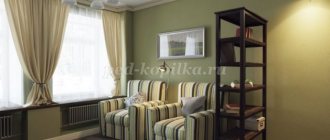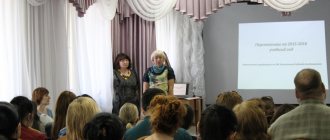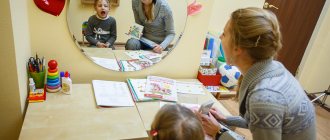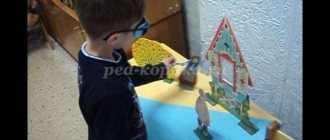Areas of work
The design of a speech therapy room in a kindergarten, school or child development center must correspond to the areas of work of the speech therapist teacher and the goals of the classes. An optimal correctional and developmental environment and a favorable psychological atmosphere must be created in the office for fruitful work with children and the successful correction or mitigation of existing disorders.
The speech therapist conducts both individual and group correctional classes, examines children to identify violations and develop an individual correction program, and provides advisory assistance to parents and teachers. The design of the speech therapy room should ensure these tasks. Thus, information stands for teachers, accessible useful information for parents, an area for correctional work with children, and so on are needed.
All types of games are actively used to develop speech activity, so the room should be divided into several zones for ease of work. At a minimum, it is necessary to equip a place to improve speech skills, which helps normalize the functioning of the vocal and respiratory apparatus, coordination, helps improve facial muscles, which activates the performance of muscle tissue, and also requires an area for eliminating psychological barriers, which helps improve cognitive mental processes.
Proper design of a speech therapy room in a school and other public or private educational institutions is important for the formation and improvement of speech. Classes with a specialist will allow you to consolidate and expand your vocabulary in various lexical areas, stimulate the use of the proposed word formation skills and ready-made constructions.
Design of a speech therapy room “Speech therapy tricks”
Municipal Preschool Educational Institution
"Kindergarten No. 160"
Shatlova Svetlana Sergeevna
Teacher-speech therapist of the 1st qualification category
G. Izhevsk
The office of a kindergarten teacher-speech therapist plays a special role as a room where children play with great pleasure. The game allows you to naturally, subtly and unobtrusively eliminate speech deficiencies, makes it possible to repeatedly repeat difficult speech therapy exercises, and master literacy. Speech activity is formed, educated, and developed in it. Speech therapists working in kindergartens have long begun to create new types of equipment, develop speech games and aids, and change the developmental environment of classrooms. I invite my colleagues to get acquainted with my ideas for its design and equipment. I have made a number of visual wall aids that help me teach literacy to preschool children with general speech underdevelopment.
Literacy learning is a purposeful, systematic process to prepare for mastery of writing and reading. My handmade manuals help me get acquainted with and remember sounds and letters. These aids are made of isolon mats with plastic pockets for letters and pictures in the form of different figures and animals: a caterpillar, Leopold the cat, colorful cars, colorful castles.
N
and the first stage of learning to read and write involves familiarization with vowel sounds and letters. The “Caterpillar” manual helps us with this. On each circle of the body is placed the letter with which the children became acquainted. And a sound is attached here with an image of the articulation of the corresponding sound. Children easily remember how a sound is pronounced and a letter looks like.
Stage II – familiarization with consonant sounds and letters. When getting acquainted with each sound, its characteristics are given: a consonant can be hard and soft, and it is immediately explained that a green sound sign means softness, a blue sign means hardness. Here we designate the symbol of sound - a letter. “Leopold the Cat” helps us with this.
To determine and consolidate the hardness and softness of consonant sounds, children are offered the “Machines” manual in different colors of blue and green. My children and I determine the hardness or softness of the initial (maybe middle or last) sound of objects from pictures and ride them on the appropriate car. For example: the picture shows a tray. The child analyzes the first sound “P”, it is a consonant, hard sound, we place it in a blue car. And he places a card with the letter P in the cabin, and “puts” a picture with a tray in the back of the car. These machines help children remember color symbols for sound-letter analysis.
And finally, to consolidate knowledge of letters and sounds, a caterpillar with vowels and cars with consonants come to the “City of Letters”, where there are only 3 castles: red, blue and green. The caterpillar puts all its vowels in the red castle, the blue car puts its consonants in the blue castle, the green car puts it in the green castle. This city serves as a small hint for children in further work with letters and sounds.
These are the speech therapy tricks I have in my office!!!
Main areas of the office
The design of a speech therapy room necessarily involves division into several zones.
- Sound pronunciation correction area (must be equipped with teaching aids and mirrors necessary for differentiation and automation of delivered sounds).
- Diagnostics and correction area (tables for diagnostics and individual work, cabinets with didactic material, educational games, specially selected taking into account the characteristics of children by age, as well as areas of correctional work).
- Area of advisory work with teachers and parents.
- Zone of organizational and planning activities (necessary to ensure the effective organization of professional activities). Here you can place a schedule of individual work, useful tips, and a to-do list.
- Play therapy area (today art therapy is actively used, which combines the artistic activities of children, including music and drawing, so it is desirable to have pencils, markers, paper, paints, plasticine and related stationery in the office).
Any of these zones can be decorated with your own hands with a little effort.
Zoning of speech therapy room material
Zoning of a speech therapy room
Brief description of the office:
Total area – 5 sq. m. The office provides 1 teacher’s workplace and 6 children’s chairs for children’s activities. The speech therapy room provides individual and group lessons with children of middle and senior preschool age.
The main areas of work carried out in the speech therapy room
1. Conducting a diagnostic examination of the speech development of preschool children.
2. Drawing up individual routes for speech therapy support and plans for subgroup classes.
3. Conducting individual and subgroup classes with children.
4. Consulting teachers and parents (conversations, demonstration of techniques for individual correctional work with the child).
5. Maintaining documentation.
Tasks of correctional work:
1) Development of general voluntary movements. Improving the static and dynamic organization of movements, speed and smoothness of switching from one movement to another.
2) Development of fine differentiated movements of the hand and fingers.
3) Formation of the psychological basis of speech. Development of cognitive mental processes: attention, perception and memory of different modalities, thinking, imagination.
4) Development of the speech apparatus. Improving the static and dynamic organization of movements of the articulatory, respiratory and vocal sections of the speech apparatus, coordinating their work.
5) Development of facial muscles. Normalization of muscle tone, formation of expressive facial expressions.
6) Formation of correct sound pronunciation. Production, automation of sounds, their differentiation.
7) Development of phonemic processes. Learning to recognize, distinguish, isolate sounds and syllables in speech, determine the place, number and sequence of sounds and syllables in a word.
 Formation of the syllabic structure of a word. Training in pronunciation and analysis of words of various syllable structures.
Formation of the syllabic structure of a word. Training in pronunciation and analysis of words of various syllable structures.
9) Development and improvement of the lexical and grammatical aspects of speech. Forming the ability to understand sentences, logical and grammatical constructions of varying degrees of complexity, clarifying, consolidating, expanding the vocabulary on lexical topics, intensifying the use of prepositional constructions, word formation skills, inflection, composing sentences and stories.
10) Preparing for literacy. Formation of the ability to establish a connection between sound and letter, skills of sound-letter analysis, continuous reading with an understanding of the meaning of what is read.
The office space is conventionally divided into zones:
Area of development of the articulatory apparatus and production of sounds; This area is equipped with a wall mirror, a work desk and 2 high chairs for activities with children.
Area for the development of fine motor skills and articulatory apparatus; There are small mirrors, an album with articulation gymnastics, tools for making sounds, manuals for finger gymnastics and general massage, and manuals for kinesiological exercises.
Speech breathing development zone; Contains materials for games and exercises to develop speech breathing.
Sound automation zone; There are methodological manuals for automation and differentiation of delivered sounds.
Zone for correction of lexical-grammatical structure and coherent speech; Contains illustrative material on sections of correctional work that stimulate the speech and personal development of children, with toys and educational games, specially selected taking into account the age characteristics of children, as well as in accordance with the directions of correctional and developmental work.
Literacy Learning Zone; Contains subject pictures for the development of sound culture, diagrams for parsing words, images of letters, icons, symbols, chips, and more.
Area of didactic aids; Didactic aids have been selected, including those made by yourself. They contribute to children's focus and concentration and increase their knowledge.
Scientific and methodological support zone; Helps to effectively organize professional activities, promotes scientific and methodological support in the process of work of methodological associations, analysis of one’s own activities in order to improve it and improve qualifications.
Diagnostic and analytical activity zone. It is necessary to conduct a psychological and pedagogical examination in order to determine the level of mental development and its compliance with age standards.
Office requirements
The design of a speech therapy room in a kindergarten or school is determined by the requirements imposed by law. The most important condition for the effective organization of the educational process is the introduction of modern interactive devices into the work, which ensure rapid processing of information.
There should be no foreign objects that distract from correctional work. The design of a speech therapy room should create a working mood in the child, a positive attitude towards the educational process, and not cause discomfort. This is an important condition for ensuring the effectiveness of correctional work.
The school office must comply with approved sanitary standards. The teacher cannot independently extend the duration of individual or group lessons. It is also prohibited to make various abbreviations.
Benefits and devices according to the Federal State Educational Standard
When designing a speech therapy room, it is necessary to use recommended aids and devices. To form the correct sound pronunciation, for example, a set of teaching aids and publications for working with breathing, inflatable toys and special albums for differentiating sounds will be useful.
To study literacy and better understand pronunciation, alphabets, developing diagrams and images are needed. To master computer literacy, the Federal State Educational Standard recommends using the “Wunderkind” interactive sensory complex. Modern interactive boards, special pictures, signal circles, aids for establishing the sound in individual words, and the like are necessary for the development of phonemic awareness in a child.
To develop visual attention and memory, various types of game elements, puzzles, pictures cut into pieces of various configurations, prefabricated pictures, special cards are usually used (example above - you can make such cards yourself). Colorful plot images and sets of texts for retelling will be useful in the process of forming coherent speech.
We need items to develop visual memory and attention; we will need various game elements, prefabricated puzzles and pictures, cut-up pictures. In addition to colorful visual aids, a modern speech therapist’s office should be equipped with suitable furniture, gaming devices, specialized equipment, preferably an interactive whiteboard and screen-sound teaching aids.
Risks and disadvantages of business
The features of any business based on the provision of educational services are more likely to be psychological than financial. Working with children and adults who have health problems (and often behavior problems) requires full dedication, preliminary preparation for each lesson, patient interaction with parents and constant additional and self-education.
Private practice has no risks, as it does not require large investments or the purchase of complex equipment. If the office is closed, furniture and benefits can be sold at residual value and continue your career as an employee.
Example: DIY puzzles
To make the simplest puzzles, just print the required picture on thick cardboard (the result is a more durable material than printing on paper) and cut it into any number of pieces. Pack each puzzle in a paper envelope, on which, for clarity, you can paste (print) a copy of the picture that will be obtained if you assemble the parts correctly.
By the way, interesting puzzles can be made using popsicle sticks (photo above). You can print a picture of a suitable size, stick it on wooden sticks, and then cut it. Such sets are durable, made of natural material, and easy to store.
Items for development
The design of a speech therapist's office should be a cross between a children's room and a classroom. This will create the most productive atmosphere for group and individual correctional classes. For the development of children you will need:
- Mirrors. They contribute to the development of speech skills, as they allow you to observe facial and articulatory movements. An example of an interesting mirror that you can make with your own hands using a special tool can be seen in the photo below.
- Soap bubbles, various pinwheels (tools for the development of speech breathing).
- Tables with toys that differ in color, weight, shape, size (develop tactile sensations).
- Modern interactive devices.
Tools and ideas for decoration
The basis for organizing a speech therapy corner in a group is a table on which a mirror is placed. Further packaging is based around these elements.
- A stand with posters and free space for displaying children's creative works (drawings, applications).
- Boxes with pictures, games. Each container must be signed. Some educators find it helpful to organize boxes by topic rather than by type of material. For example, when studying the topic “Animals,” one box contains pictures with domestic and wild animals, their habitats, food, as well as crafts made from natural materials on the theme of animals, and games.
- Jars with pebbles and buttons for the development of fine motor skills.
All boxes of materials must be signed
This is interesting. Since the book corner is recommended to be located next to the correction center, the table and bookcase can be a single composition.
What you can do with your own hands
The subject-development environment in kindergarten is designed not only with purchased materials, but also with objects created by the hands of the teacher and parents. To a greater extent, this is done so that children, seeing the results of manual labor, treat it with respect. If we consider the speech therapy corner from the point of view of the possibilities of designing on our own, then in this sense the most optimal would be to create a stand. To do this, you will need a sheet of plywood of the required size and shape, onto which the fabric is stretched through a foam rubber pad. The structure is secured with a construction stapler. Thanks to the soft surface
What you can do with your own hands
It is very easy to make many visual aids for decorating a speech therapy room with your own hands. These are colorful tables with sounds, images and useful information. A great idea is a magnetic or cork board and a set of cards so that you can work more effectively with children and not clutter the office with a large number of tables that distract from work.
To decorate a speech therapy room (photos will help the teacher decide on the best option), you can purchase bright buttons for a cork board, cardboard and colored paper to create the necessary cards on your own (it is better to print some materials in advance on a color printer rather than draw them yourself), the board itself and frame.
How should the office be decorated?
To work, you will need an office in a commercial child development center, a private clinic, a shopping center, or a converted apartment on the ground floor with a separate entrance. A big advantage will be the location near educational institutions, transport stops, and in densely populated residential areas.
A small bright room of 20 square meters is suitable. m, equipped with a hand washing station and a waiting room for parents. The design should be concise, especially if you plan to work with both children and adult patients. The following pieces of furniture are required:
- study table and chairs;
- large mirror;
- bookshelf;
- cooler with drinking water;
- board;
- toy rack;
- sofa in the waiting area.
In the future, free funds can be invested in the purchase of an interactive speech therapy table, a massage couch, and additional play sets.
DIY drawing board
From an ordinary piece of plywood, using special paint, you can make a board for drawing with chalk. Buying a finished board will cost a hefty sum, but one made by hand is no different from the factory version. The base (it can even be ordinary cardboard) needs to be painted with a mixture of the following ingredients: one tablespoon of water, two tablespoons of alabaster, three tablespoons of black acrylic paint.
First you need to mix alabaster and water in a ratio of one part to two, then gradually introduce this mixture into the paint. If the mass turns out to be too dense, you can add a little water. The point here is that different paints have different densities. The paint is applied to the base with a brush. Everything needs to be done quickly enough, because the composition quickly begins to thicken, which significantly complicates the work.
For durability, it is better to apply three coats of paint. After drying, you need to rub the board with chalk and then wipe it with a dry towel. This is necessary to harden the surface. It is advisable to insert the painted base into a frame so that the board looks neat.






